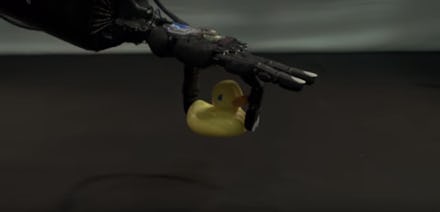Watch these self-learning robot hands adapt to their environment

As humans, we can forget the high level of sophistication that our every movement requires. Our hands are particularly complicated, with about 33 joints, 26 bones and a complex network of muscles and ligaments. Recreating human hands takes some seriously advanced science; it'll be a while before there's anything resembling C3PO from Star Wars.
Despite the challenge, scientists at Bielefeld University in Germany developed robotic hands that replicate some of the complexity in human hands. They're equipped with fingernails, tactile sensors and an AI brain that helps robots learn about objects by touching them.
"It's simply about becoming familiar with unfamiliar objects, and testing out how these objects work," Thomas Schack, a cognitive psychologist and professor heading the project, said in a video released by Bielefeld University. "But it's also about learning about the objects' characteristics — something that happens seemingly playfully with humans."
How the hand works: In the video, a man tells the robot to pick up an apple and put it in a basket. The robot complies, although slowly, showing it has learned to identify an apple's round shape by playing with it and match the object to the word ("apple") describing it.
It may not sound like a big deal, but most robots have just a few prongs for hands or must be taught about objects by being supplied with complex models of items in the world.
"We don't even think twice about it when we handle such objects ourselves," Helge Ritter, a professor at Bielefeld University and a leader on the project, says in the video.
But the robot isn’t just a set of arms devoid of personality. It has a monitor head named Flobi, which is able to process language, gestures and facial expression of humans. The hope is that human interaction can give the robot feedback and teach it more about the world.
What can it do for us? Though direct applications are still left for the imagination, these robotic hands could conceivably lead to a future where, say, recyclables could be identified and sorted in warehouses — or the missing TV remote could be found and delivered to us.